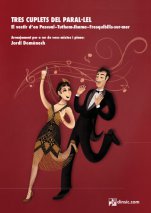Tres cuplets del Pral·lel (per a veus mixtes)

Inside Pages
Musical Arrangement
Field
Music Schools and Conservatoires Advanced Level
Scores Advanced
Collection
Cuplets del Paral·lel Nr. 2
Language
Spanish, Catalan, English, Latin
Format
Score
Contents
The period when the cuplé music style took off was a complex time for Barcelona, demographically speaking, as the population almost doubled in size between 1910 and 1930. Many people migrated to the capital city from other areas in Catalonia and also from places such as Murcia, Aragon and Valencia. These social changes led to the creation of certain archetypes used in the world of popular culture, like the young servants or female shop assistants missing their home town, as they tried to deal with life in an industrialized city.(...)
(...) With these cuplés, exquisitely and wonderfully arranged by the composer Jordi Domènech, we enjoy not just the history of the Paral·lel Theatre in Barcelona but also a sociological testimony of a moment in our recent history. It was a fascinating time which also saw the discovery of Tutankhamun’s tomb in 1922, a moment of magic reflected in Tuthom Jahma by Joan Costa and Manuel Sugrañes, a cuplé whose message is still valid today:
A Egipte com veíeu (In Egypt, as you can see,)
tot són mòmies, ai déu meu, (Mummies are found all over,)
i en aquí si us hi fixeu (And if you look around here too,)
es veuen mòmios per tot arreu. (You’ll also see mummies* everywhere.)
[Translator’s note: ‘mummy’ is also a colloquial word for a fool in Catalan]
Oriol Perez i Treviño
Structure
- El vestir d'en Pasqual (Joan Viladomat, música / Juan Misterio (text)
- Tuthom Jahma (Joan Costa, música / Manuel Sugrañes, text)
- Fresquibilis-sur-mer (Enric Clarà, música / Manuel Sugranyes, text)
Tuthom Jahma (Joan Costa, música / Manuel Sugrañes, text)
Fresquibilis-sur-mer (Enric Clarà, música / Manuel Sugranyes, text)
In these arrangements of pieces from the Paral·lel Theatre, I have attempted to be a little more drastic in my intervention as the music has a much more practical air and, especially regarding the piano, it is written in a more basic style. In the original pieces, the music for piano uses the left hand to play the harmony while the right one constantly doubles the melody so that the soloist – who may not have been able to dedicate enough time to studying the music – never feels unsupported.
With this end in mind, firstly I converted the original accompaniment, which often seemed to be merely a rough guide, into a veritable piano accompaniment, expanding the piano’s tessitura and enriching the style. Secondly, I converted the soloist’s melody into a collective piece, sharing out the interventions between different voices according to their use in the choir. The choir part is relatively easy because, to tell the truth, the success of this music will depend on the flair, freshness and attitude it is performed with and, to ensure this, I have aimed to leave as few hurdles as possible in the music.
Jordi Domènech (Arranger)
Technical Specifications
Measurements
21 x 29,7 cm, vertical
Binding
Staple
Number of Pages
32
ISMN
979-0-69239-181-4
Editor
DINSIC Publicacions Musicals









